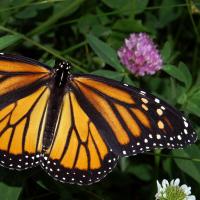Monarch Butterfly Flight Inspires Micro Air Vehicles

Studying the biomechanics of the amazing flight of the monarch butterfly will enhance national security.
At least that’s the goal of Dr. Chang-kwon Kang, assistant professor in the Department of Mechanical and Aerospace Engineering at The University of Alabama in Huntsville, who was awarded a grant from the National Science Foundation to research the possibilities of long-range micro air vehicles with enhanced flight efficiency and superior flight range inspired by monarch butterflies.
What’s so special about monarch flight?
A monarch’s flight is highly efficient, characterized by the flexibility and slow flapping tempo of their wings to the mechanical coupling of wing and body movements. They also fly at high altitudes. Monarchs have been observed soaring on thermal currents at altitudes up to 1,250 meters, and their overwintering grounds are at altitudes of approximately 2,400 to 3,600 meters—nearly 2 miles above sea level.
The research on developing long-range micro air vehicles will explore high-altitude flight as a critical component to long-range monarch migration, which is the longest migration distance among insects, up to 4,000 kilometers or almost 3,000 miles.
The fall migration from August to November is when the fourth generation of monarchs—the great-great grandchildren born in the northern U.S.—begins the annual journey (by instinct alone) to central Mexico, where they hibernate in pine and fir trees. The U.S. Forest Service notes monarchs can travel between 50–100 miles a day, and it can take up to two months to complete their journey.
"These vehicles will enhance national security by allowing long-term surveillance of large areas and by providing long-range reconnoitering capacity for search and rescue," says Dr. Kang. "They will also improve the national quality of life by enabling long-term monitoring of environmental hazards."
“What good is the monarch butterfly?”
The late Dr. Lincoln Brower, longtime champion of the monarch, was frequently asked, “What good is the monarch butterfly?” Here’s Dr. Brower’s eloquent response:
“Needless to say, I am extremely irritated when anybody asks that question! Economically, it has practically no value to our society, other than facilitating education. How do you put a price on that? But the beauty of it? I’ve seen the Mona Lisa in Paris. What good is the Mona Lisa? It’s a painting on a piece of paper. But we revere it as part of our culture and part of our tradition...We’re too pragmatic in this country, and I think we need to realize that biological treasures such as the monarch are just as valuable as the Mona Lisa. We have to start changing our way of thinking about things.”
Do you catch a glimpse of orange and black in your backyard? If not, it’s probably because monarch numbers have decreased significantly due to many factors, including habitat loss and pesticides. Remember, monarch caterpillars are completely dependent on milkweed for their survival. Help save the monarchs by planting native milkweed (not treated with neonicotinoid insecticides) and nectar plants that are local to your area.

